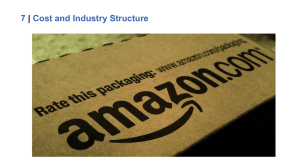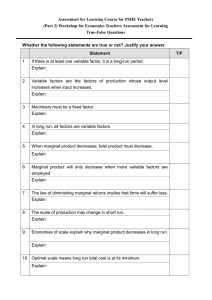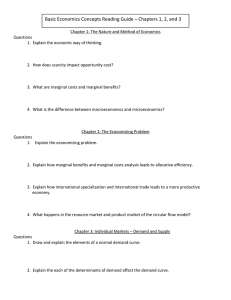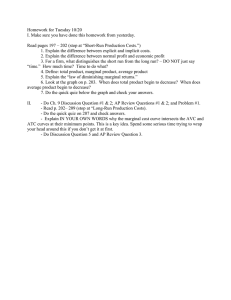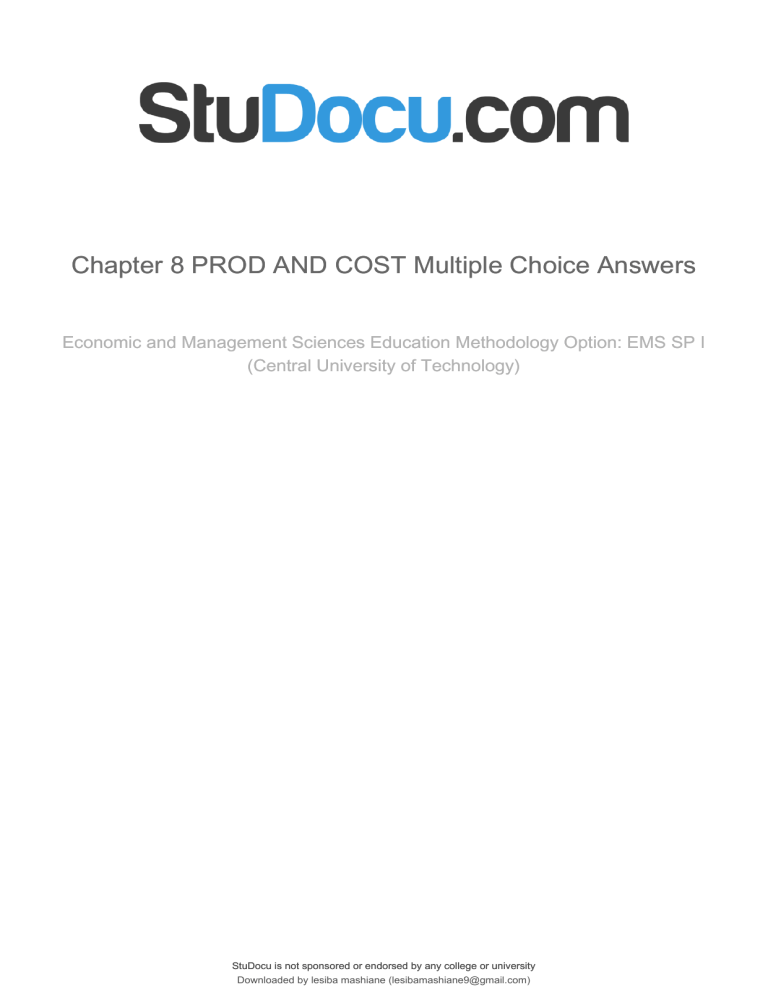
lOMoARcPSD|13427186 Chapter 8 PROD AND COST Multiple Choice Answers Economic and Management Sciences Education Methodology Option: EMS SP I (Central University of Technology) StuDocu is not sponsored or endorsed by any college or university Downloaded by lesiba mashiane (lesibamashiane9@gmail.com) lOMoARcPSD|13427186 MULTIPLE CHOICE QUESTIONS TESTBANK – CHAPTER 8 Go back to Testbank MEMORANDUM Answer the following questions by selecting the appropriate answer from the list below. Question 1 Use the following data to answer Questions 1 and 2: Quantity produced 1 2 3 4 5 Fixed costs 100 100 100 100 100 Variable costs 200 300 350 700 1 400 What is the average cost of producing 4 units? A. B. C. D. E. 100 700 25 175 200 Question 2 What is the marginal cost of the third unit? A. B. C. D. E. 100 300 50 700 850 Question 3 In economics, the short run is a period of time: A. B. C. D. E. of one year or less. in which all inputs are variable. in which all inputs are fixed. in which the quantity of at least one input is fixed and the quantities of the other inputs can be varied. in which all inputs are variable but technology is fixed. ©VANSCHAI KPUBLI SHERS Downloaded by lesiba mashiane (lesibamashiane9@gmail.com) lOMoARcPSD|13427186 Question 4 Use the following table which shows the short-run production function of a cricket ball manufacturer and answer Questions 4 and 5. Number of machines Number of workers Output (Cricket balls/day) 8 0 0 8 1 60 8 2 140 8 3 230 8 4 300 8 5 340 8 6 360 What is the average product of labour when two workers are employed? A. B. C. D. E. 30 cricket balls 70 cricket balls 80 cricket balls 140 cricket balls 280 cricket balls Question 5 Diminishing marginal returns set in when the _______ worker is added to the production process. A. B. C. D. E. second third fourth fifth sixth Question 6 The average total cost of producing cell phones in a factory is R300 at the current output level of 100 per week. If total fixed cost is R20 000 per week, then: A. B. C. D. E. average variable cost is R100. average fixed cost is R400. total cost is R10 000. total variable cost is R30 000. marginal cost is R300. ©VANSCHAI KPUBLI SHERS Downloaded by lesiba mashiane (lesibamashiane9@gmail.com) lOMoARcPSD|13427186 Question 7 Consider a firm that manufactures surfboards. Presently the firm is hiring 5 workers at a wage rate of R20/hour. The firm is able to produce 50 surfboards per hour. The firm decides to hire an additional worker. The marginal product of that worker is 30 surfboards per hour. What is the marginal cost of output associated with hiring the sixth worker? A. B. C. D. E. R20 R1,50 R0,67 R2 R30 Question 8 The vertical distance between the average total cost curve and the average variable cost curve: A. B. C. D. E. increases as output increases. decreases as output increases. is equal to total variable cost per unit of labour. is equal to total variable cost. is negative. Question 9 The marginal cost curve intersects the: A. B. C. D. E. AC, AVC and AFC curves at their minimum points. AC and AFC curves at their minimum points. AVC and AFC curves at their minimum points. AC and AVC curves at their minimum points. TC and TVC curves at their minimum points. ©VANSCHAI KPUBLI SHERS Downloaded by lesiba mashiane (lesibamashiane9@gmail.com) lOMoARcPSD|13427186 Question 10 Use the following table which represents the short-run total cost schedule of a mineral water manufacturer and answer Questions (a) and (b). Labour (workers per day) Output (bottles of mineral water per day Total cost (R) 0 1 2 3 4 5 0 30 80 120 140 150 400 700 1 000 1 300 1 600 1 900 Question (a) When output increases from 30 to 80 bottles of mineral water, the marginal cost of producing one of those 50 bottles of mineral water is: A. B. C. D. E. R5 R6 R12,50 R20 R30 Question (b) The average variable cost to the firm when 30 bottles of mineral water are produced is: A. B. C. D. E. R10 R13,33 R23,33 R30 R70 Question 11 Suppose a firm produces 20 units of output per month and has a total variable cost of R3 000 per month. If its average fixed costs are R400 per month, what are its total costs per month? A. B. C. R3 400 R3 800 R6 000 ©VANSCHAI KPUBLI SHERS Downloaded by lesiba mashiane (lesibamashiane9@gmail.com) lOMoARcPSD|13427186 D. E. R8 000 R11 000 Question 12 Which one of the following statements is correct? A. The short run is a time period of one year or less. B. The short run is a period of time during which the quantities of all inputs can be varied, but technology is held constant. C. The short run is a period of time during which the quantity of at least one input is fixed and the quantities of the other inputs can be varied. D. The long run is a period of time during which the quantities of all factor inputs are fixed. E. The time period separating the short run from the long run is at least 3 months. Question 13 When the marginal product of labour is less than the average product of labour: A. B. C. D. E. the average product of labour is decreasing. total product is increasing at an increasing rate. the marginal product of labour is increasing. the marginal product of labour curve is positively sloped. the firm is experiencing increasing marginal returns. Question 14 Suppose that a shoe manufacturer that employs 6 workers is able to increase the average product of labour from 5 pairs of shoes per hour to 6 pairs of shoes per hour by hiring a seventh worker. The seventh worker’s hourly marginal product is: A. B. C. D. E. 1 pair of shoes. 7 pairs of shoes. 11 pairs of shoes. 12 pairs of shoes. 30 pairs of shoes. Question 15 Use the following table which describes the daily production possibilities facing a small brewery and answer the question below. Labour (L) 1 2 Average Product of Labour (APL) (litres of juba) 3 6 ©VANSCHAI KPUBLI SHERS Downloaded by lesiba mashiane (lesibamashiane9@gmail.com) lOMoARcPSD|13427186 3 4 5 8 9,5 10 The marginal product of the third labourer is: A. B. C. D. E. 2,67 litres of juba. 2 litres of juba. 8 litres of juba. 12 litres of juba. 24 litres of juba. Question 16 The vertical distance between the total cost and the total variable cost curves: A. B. C. D. E. decreases as output increases. increases as output increases. is equal to average fixed cost. is equal to total fixed cost is equal to marginal cost. Question 17 When the marginal cost curve is above the average total cost curve: A. B. C. D. E. the average fixed cost curve is rising. the average fixed cost curve is horizontal. the marginal cost curve is falling. the marginal cost curve reaches a minimum. the average total cost curve is rising. Question 18 Marginal cost is the amount that: A. B. C. D. E. total cost increases when one more labourer is hired. fixed cost increases when one more labourer is hired. variable cost increases when one more labourer is hired. total cost increases when one more unit of output is produced. fixed cost increases when one more unit of output is produced. Question 19 Use the table below to answer Questions (a) to (c). The fixed cost to the firm is R500. ©VANSCHAI KPUBLI SHERS Downloaded by lesiba mashiane (lesibamashiane9@gmail.com) lOMoARcPSD|13427186 Cocaine (total product) (units) Total Variable Cost (TVC) (rands) 1 2 3 4 5 6 200 360 500 700 1 000 1 800 Question (a) The average variable cost to the firm when 4 units of cocaine are produced is: A. B. C. D. E. R175 R200 R300 R700 None of the above. Question (b) The average total cost to the firm when 4 units of cocaine are produced is: A. B. C. D. E. R175 R200 R300 R700 None of the above. Question (c) The marginal cost of the sixth unit of cocaine is: A. B. C. D. E. R200 R300 R700 R800 None of the above. Question 20 A situation where average variable cost is at a minimum can be associated with a situation where: A. B. C. D. average total cost is at a minimum. marginal cost is at a minimum. average product is at a maximum. marginal product is at a maximum. ©VANSCHAI KPUBLI SHERS Downloaded by lesiba mashiane (lesibamashiane9@gmail.com) lOMoARcPSD|13427186 E. total product is at a maximum. Question 21 We can associate a situation where average variable costs fall with a situation where: A. B. C. D. E. the total product curve decreases. the total product curve is at the point of inflection. the marginal product curve is above the average product curve. total costs fall. total costs increase at an increasing rate. Question 22 Which of the following cost curves does not have a shape that is explained by the law of diminishing marginal returns? A. B. C. D. E. Total variable costs Total costs Average total costs Average fixed costs Average variable costs Question 23 If the marginal cost curve is below the average cost curve, we can say that: A. B. C. D. E. total costs are falling. the total cost curve has already reached its maximum. the average cost curve has not yet reached its minimum. average product is falling. diminishing returns have not yet set in. Question 24 Suppose a firm produces 15 units of output per month and has a total variable cost of R5 000 per month. If its average fixed costs are R350 per month, what are its total costs per month? A. B. C. D. R350 R5 000 R5 250 R5 350 ©VANSCHAI KPUBLI SHERS Downloaded by lesiba mashiane (lesibamashiane9@gmail.com) lOMoARcPSD|13427186 E. R10 250 Question 25 Complete the following table and use the data to answer the questions below. Quantity Total revenue Average revenue 1 Marginal revenue 10 2 16 3 2 4 5 5 20 6 -2 Question (a) The total revenue of four units is: A. B. C. D. E. 10 16 18 20 14 Question (b) The average revenue of six units is: A. F. G. H. I. 8 6 5 4 3 Question (c) The marginal revenue of four units is: A. J. K. L. 0 2 4 6 ©VANSCHAI KPUBLI SHERS Downloaded by lesiba mashiane (lesibamashiane9@gmail.com) lOMoARcPSD|13427186 M. -1 Question 26 Complete the following table and use the data to answer the questions below. 0 1 2 3 4 5 Output Total cost Marginal cost (units) (R) (R) Average fixed cost (R) Average variable cost (R) 100 110 130 166 220 300 Question (a) The marginal cost of the fourth unit is: A. N. O. P. Q. 10 20 36 54 80 Question (b) The average fixed cost of the fifth unit is: A. R. S. T. U. 10 20 25 50 100 Question (c) The average variable cost of the third unit is: A. V. W. X. 11 22 33 30 ©VANSCHAI KPUBLI SHERS Downloaded by lesiba mashiane (lesibamashiane9@gmail.com) Average total cost (R) lOMoARcPSD|13427186 Y. 40 Question (d) The average total cost of the second unit is: A. 55 Z. 60 AA. 65 BB. 100 CC. 110 Question 27 Complete the following table and use the data to answer the questions below. Output (units) 1 2 3 4 5 6 Total revenue (R) 10 Average revenue (R) Marginal revenue (R) 15 6 10 42,5 2,5 Question (a) The total revenue of six units is: A. 10 DD.30 EE. 40 FF. 45 ©VANSCHAI KPUBLI SHERS Downloaded by lesiba mashiane (lesibamashiane9@gmail.com) lOMoARcPSD|13427186 GG.50 Question (b) The average revenue of three units is: A. 7,5 HH.10 II. 12 JJ. 15 KK. 6 Question (c) The marginal revenue of five units is: A. 2,5 LL. 4 MM. 5 NN. 6 OO. 10 Question 28 Complete the following table and use the data to answer the questions below. Units of labour (N) 1 2 3 4 5 6 Total product (TP) Average product (AP) Marginal product (MP) 20 45 66 21 100 14 Question (a) The total product of four units is: A. 20 PP. 50 QQ. 80 RR. 84 SS. 114 ©VANSCHAI KPUBLI SHERS Downloaded by lesiba mashiane (lesibamashiane9@gmail.com) lOMoARcPSD|13427186 Question (b) The average product of six units is: A. 19 TT. 20 UU.21 VV. 22 WW. 22,5 Question (c) The marginal product of five units is: A. 14 XX. 16 YY. 18 ZZ. 20 AAA. 25 ©VANSCHAI KPUBLI SHERS Downloaded by lesiba mashiane (lesibamashiane9@gmail.com)

